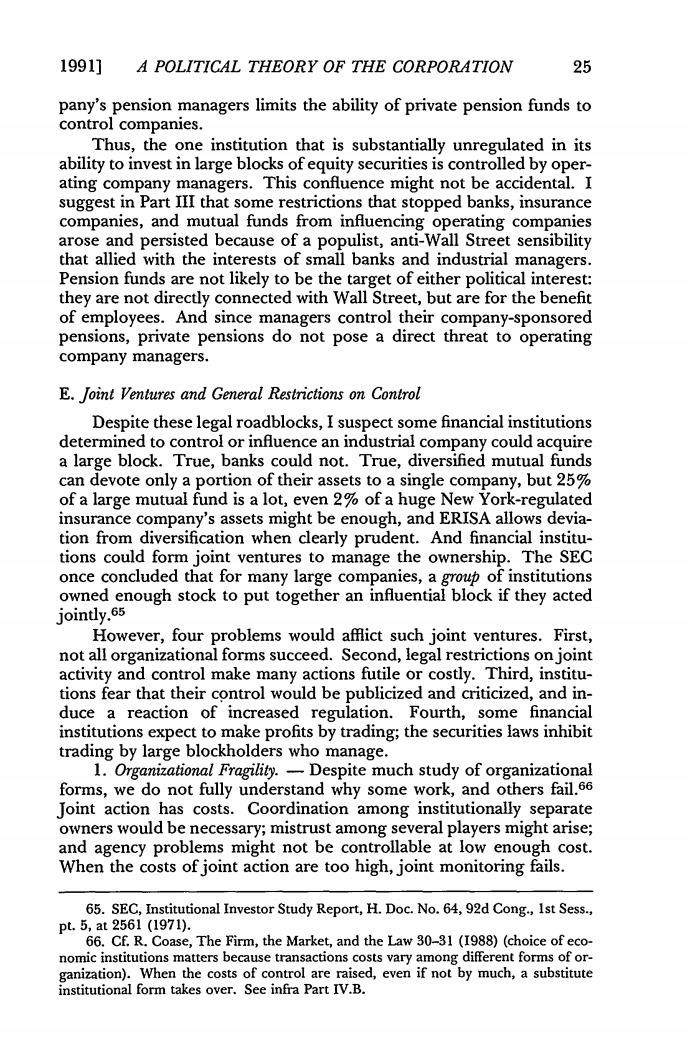正在加载图片...

1991] A POLITICAL THEORY OF THE CORPORATION 25 pany's pension managers limits the ability of private pension funds to control companies. Thus,the one instifution that is substantially unree ability to invest in large blocks of is This com intha some restrictions that stopped banks.insurance ce might no companies,and mutual funds from influencing operating companies arose and persisted because of a populist,anti-Wall Street sensibility that allied with the interests of small banks and industrial managers Pension funds s are not likely to be the ta et of eithe er po olitical int tere they are not direct connected with Wall Street but are for the benefi of employees.And since managers control their company-sponsored pensions,private pensions do not pose a direct threat to operating company managers E.Joint Ventures and General Restrictions on Contro Despite these legal roadblocks,I suspect some financial institutions determined to control or influence an industrial company could acquire a large block.True,banks could not.True,diversified mutual funds can devote only a portion of their assets to a single company,but 25% of a large mutual fund is a lot,even%of a hu e New york-r nilated ins ur mpany s sset might be enough,an d ERISA alloy sdevia tion from diversification when clearly prudent. And financial institu- tions could form joint ventures to manage the ownership.The SEC once concluded that for many large companies,a groub of institutions owned enough stock to put together an influential block if they acted jointly.65 However,four problems would afflict such joint ventures. First, not all organizational forms succeed.Second,legal restrictions on joint activity and control make many actions futile or costly.Third,institu- tions fear that their control would be publicized and criticized,and in- duce reaction of in d on. Fourth me finar institutions expec e profits by trading;the securities laws inh trading by large blockholders who manage. 1.Organizational Fragility.-Despite much study of organizationa forms,we do not fully understand why some work,and others fail.6e Joint action has costs.Coordination among institutionally separate ners would be e necessary;mistrust among s and agency problems might not be controllal 1 cost When the costs of joint action are too high,joint monitoring fails. 65.SEC,Institutional vN6,92d Cong.,Ist Sess 1 56.Cf.R.Coase,The Firm,the Market,and the Law 30-31(1988)(choice of eco- nomic institutions matters because transactions costs vary among different forms of or- ganization).When the costs of control are raised,even if not by much,a substitute institutional form takes over.See infra Part IV.B 1991] A POLITICAL THEORY OF THE CORPORATION 25 pany's pension managers limits the ability of private pension funds to control companies. Thus, the one institution that is substantially unregulated in its ability to invest in large blocks of equity securities is controlled by operating company managers. This confluence might not be accidental. I suggest in Part III that some restrictions that stopped banks, insurance companies, and mutual funds from influencing operating companies arose and persisted because of a populist, anti-Wall Street sensibility that allied with the interests of small banks and industrial managers. Pension funds are not likely to be the target of either political interest: they are not directly connected with Wall Street, but are for the benefit of employees. And since managers control their company-sponsored pensions, private pensions do not pose a direct threat to operating company managers. E. Joint Ventures and General Restrictions on Control Despite these legal roadblocks, I suspect some financial institutions determined to control or influence an industrial company could acquire a large block. True, banks could not. True, diversified mutual funds can devote only a portion of their assets to a single company, but 25% of a large mutual fund is a lot, even 2% of a huge New York-regulated insurance company's assets might be enough, and ERISA allows deviation from diversification when clearly prudent. And financial institutions could form joint ventures to manage the ownership. The SEC once concluded that for many large companies, a group of institutions owned enough stock to put together an influential block if they acted jointly.65 However, four problems would afflict such joint ventures. First, not all organizational forms succeed. Second, legal restrictions onjoint activity and control make many actions futile or costly. Third, institutions fear that their control would be publicized and criticized, and induce a reaction of increased regulation. Fourth, some financial institutions expect to make profits by trading; the securities laws inhibit trading by large blockholders who manage. 1. Organizational Fragility. - Despite much study of organizational forms, we do not fully understand why some work, and others fail. 66 Joint action has costs. Coordination among institutionally separate owners would be necessary; mistrust among several players might arise; and agency problems might not be controllable at low enough cost. When the costs ofjoint action are too high, joint monitoring fails. 65. SEC, Institutional Investor Study Report, H. Doc. No. 64, 92d Cong., 1st Sess., pt. 5, at 2561 (1971). 66. Cf. R. Coase, The Firm, the Market, and the Law 30-31 (1988) (choice of economic institutions matters because transactions costs vary among different forms of organization). When the costs of control are raised, even if not by much, a substitute institutional form takes over. See infra Part IV.B